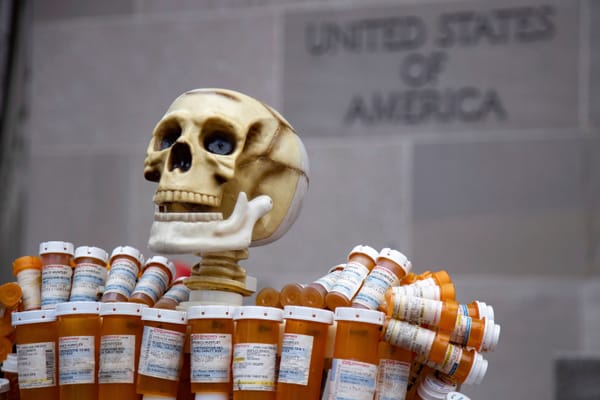Since the late 1990s, more than half a million Americans have died from opioid overdoses—likely the worst drug epidemic in American history. At the outset of the crisis, the pharmaceutical industry was the primary drug pusher, and Appalachia the most affected region. Today, most deaths are caused by illicit street drugs like fentanyl, and the damage has spread to virtually all of society. Last year alone, more than 80,000 Americans died from opioid overdoses. The resulting devastation is difficult to fully comprehend. Across large swaths of rural America, opioids have contributed to “deaths of despair,” which have led to a shocking drop in life expectancy. Meanwhile, great American cities like San Francisco have become scenes of appalling degradation, as fentanyl addicts wander the streets and die on the sidewalks.
It’s easy to forget that this disaster, like many others in history, began with an altruistic premise. In 1996, Purdue Pharma started selling OxyContin, a potent form of the opioid-based painkiller oxycodone. More than just a new painkiller, however, OxyContin was the culmination of a movement in medicine to change the way we treated and thought about pain. Doctors at the American Pain Society and other organizations had been arguing that millions were suffering needlessly due to an outdated stigma against prescribing opioids. The drugs had been unfairly demonized, they said. Advocates for opioids even had a term for this prejudice: “opiophobia.” If we could only let go of this bias, medical science would take care of the rest.
Purdue Pharma was owned by the Sackler family. Even before OxyContin allowed them to amass billions, the Sacklers were known for their philanthropy and generous funding of the arts. The patriarch of the clan, Arthur Sackler, was the founder of modern pharma advertising and p.r. Arthur died in 1987, a few years before federal reforms allowed his industry to truly come into its own. In the 1990s, the Food and Drug Administration loosened its restrictions on lobbying and advertising. It did so for what seemed like good reasons. In the wake of the AIDS crisis, many came to think that government bureaucracy was putting up too many obstacles that kept patients from getting the drugs they desperately needed.
The Sacklers were well-positioned to take advantage of a new era that saw business and humanitarianism merge. OxyContin was a powerful narcotic with a controlled-release coating that made it so the drug filtered continuously into the bloodstream. Supposedly, this would reduce the risk of addiction—at least, that’s how Purdue sold it. But the real innovation was in the OxyContin marketing campaign, premised on the claim that there was an epidemic of non-malignant chronic pain affecting tens of millions of Americans. Before Purdue even started selling the drug, the company lobbied the FDA to get the label they wanted. Until then, potent opioids were typically only prescribed to cancer patients in palliative care. Now that all changed.
